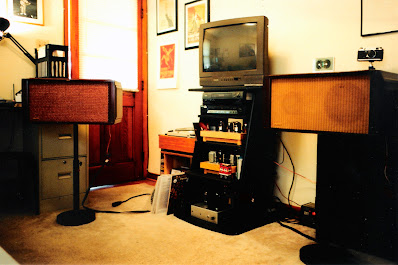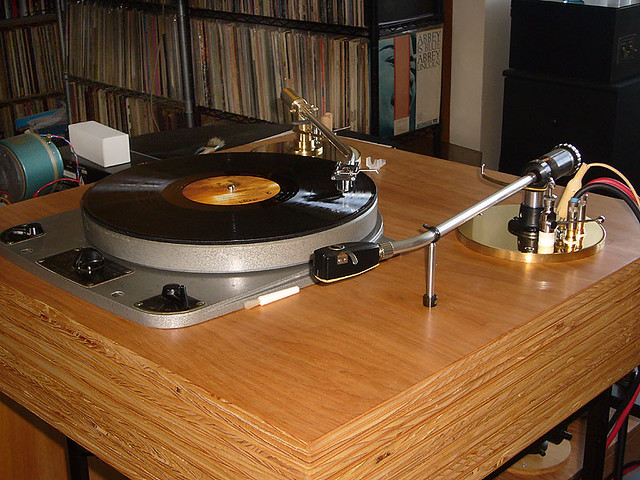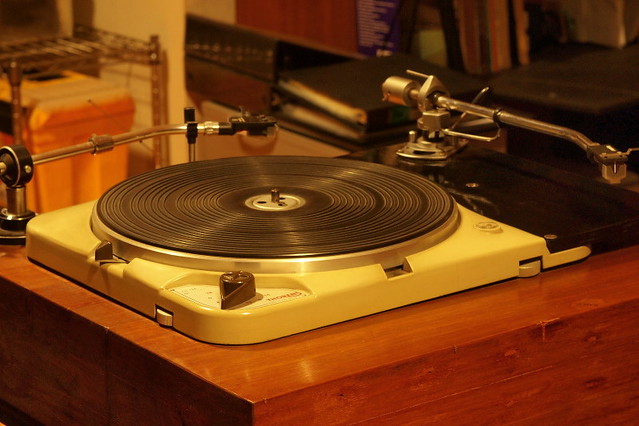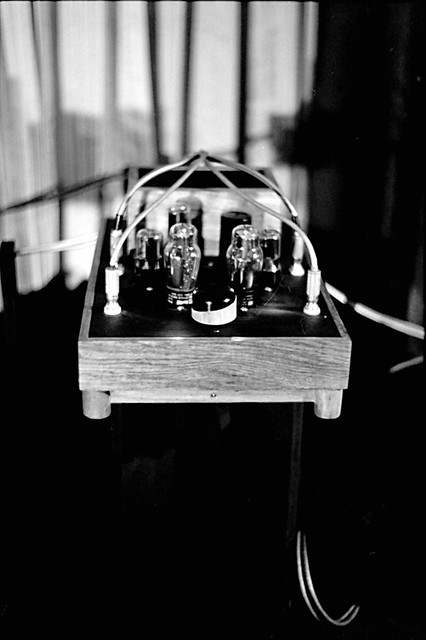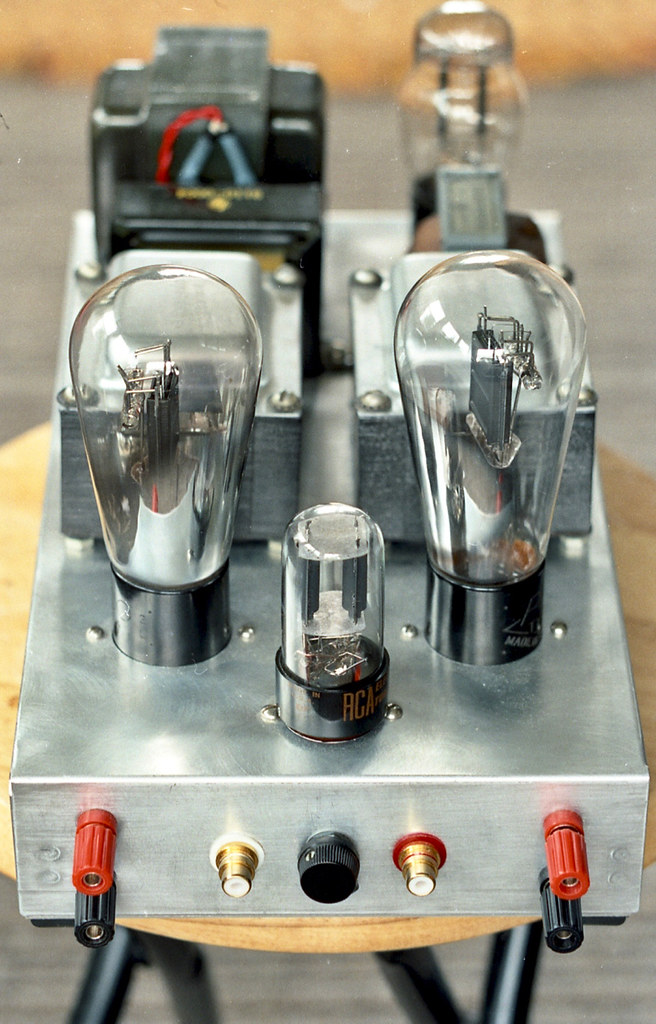Jensen Duette "Treasure Chest" [DU300] finished in
Mahogany from the mid 50s
Jensen Duette "Treasure Chest" [deluxe version of the
one below] interior view, 2-way system with P8RL mid-woofer, RP106 cylindrical
metal horn tweeter. The phenolic diaphragmed alnico magnet compression driver
is the same motor assembly used in the later RP102 and RP103. Simple 1st order
crossover network using a 2uf paper capacitor [beeswax?] and a transformer for
attenuation and impedance matching. These came with bare panels and best left
alone for ultimate sonics.
Jensen Duette "Reproducer" [DU201]. Essentially the same
speaker as above but uses a plastic horn lens and cheaper Fabrikoid finish,
from the mid 50s
Heathkit SS1 sold as a kit in the mid 50s until the 60s. Simple
2-way bass reflex utilizing the driver components below. The crossover consist
merely of a 2uf paper cap and an L-pad tweeter attenuator. Also no damping
inside the plywood box.
Jensen P8RL 8" woofer: frequency response 50 - 3,000 cycles,
impedance: 8 ohms, 1/2 lb. alnico magnet, maximum power 20W
Jensen RP103 tweeter: compression horn driver with alnico magnet
and phenolic diaphragm frequency response 2,000-15,000, impedance 16 ohms,
maximum power 30W
These are the components [or later versions] typically encountered
inside the Heathkit SS1 and Eico HFS-1 speaker systems.
Looking for something a
little less exotic and more affordable than WE or Altec. Try these Jensens
which sold in great numbers in the 50s-60s. These are JE Labs budget vintage
speaker faves. Perhaps a little less transparent over the entire frequency
range and less "snappy" in the midrange, but they are pretty damn
musical and efficient. I am listening to my Duettes right now driven by my
SE71A amp.
If you can find them
with the cabinets in good condition, these may have great WAF, especially if
she is into modern retro or mid century modern designs like Charles Eames,
George Nelson, Noguchi and etc. I am still looking forward to finding a pair of
Heathkit SS1 or DU300 in blonde oak finish with matching wooden or metal wire
stands at a yard sale or thrift store. So ask around, maybe an old relative has
them stored in the basement or attic.
The Jensen P8RL 8"
woofer may look cheap [in spite of the fact that people pay $300/pr. for
similar the looking and even smaller 6" Diatone PM610 FR] but what sets it
apart from modern designs is its natural sounding midrange due to the stiff
paper cone that has a built in surround which makes it a pretty quick responding
driver [good for the midrange] yet if properly loaded in a proper bass reflex
cabinet, there is enough energy below 80 hz to keep you happy just like any
modern monitors. I can assure you that the smooth midrange response up to 3,000
is a bit pessimistic because it is almost usable as a full range driver that's
why only a 2uf cap in series to the RP103 was used to crossover at 5,000
cycles. The RP103 may not have the silky, detailed and ribbon like response of
an Altec 3000, but this phenolic diaphragmed horn tweeter is smooth and sweet
with plenty of detail until it rolls off gently above 13 khz.
Compared to the Jensen
Duette, the Heathkit version has slightly bolder presentation because of more
energy in the bass frequencies. This maybe due to the heavier cabinet material
[5/8" plywood as opposed to 1/2" used in the Jensen] and lower tuning
of the bass reflex [that cabinet is a bit deeper]. However the Jensen sounds
smoother and slightly more refined. I can live with either one. Unfortunately I
do not have a copy of the Heathkit cabinet plan. If someone can send me a jpeg
scan, I will upload it in this page.
Take note that these
cabinets were designed to be placed horizontally on bookshelves and during that
time, people did not pay much attention to mirror image placement of drivers. Stand mounting
horizontally is best for pure sound if you have the space. If you crave for
that sweet and airy extreme highs which will bring these speakers abreast with
the 21st century you may also add the Fostex FT-17H as a super tweeter Just use a .5uf oil cap
and adjust levels to taste with an 8 ohm L-pad.
If you have or find the
drivers without the cabinet, try the two Jensen plans below. Make sure you use
1/2" plywood as per instructions and make it rigid. No damping material
required for best sound and please don't use MDF. The only modification I may
consider is using a removable grill covered with silk cloth as suggested by
Walt Bender in his "Ask Walt" series. These two drivers also sound
good in an open baffle.
Cabinet plans from Jensen
Eico also marketed their
own version, the HFS-1, using these two Jensen drivers. I have seen them but
never heard them in a system. These are also worth hunting down. Just remember
that these were budget designs and if your taste and pocket crave for ultimate transparency
and finesse, these may not be suitable. But for apartment dwellers or those on
a tight budget who dabble with SE amps these speaker systems may be your ticket
to musical pleasure.
I am sure there other
sleepers out there, particularly drivers imported from Japan and Germany by
radio chain stores during the late 50s and 60s. Actually some choice Japanese models
from this era are now being re-exported back to Japan.
Link to Jensen Ultraflex enclosure





